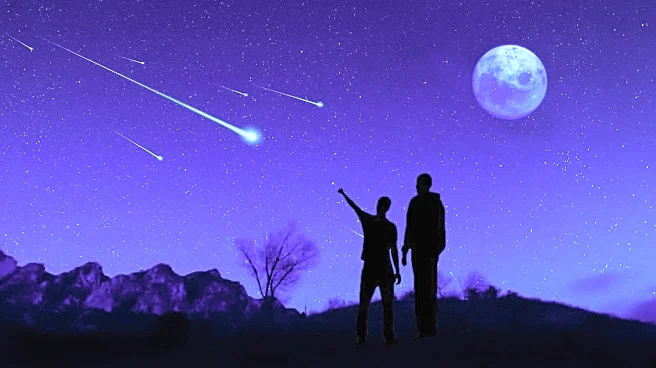What's Happening?
The November beaver supermoon is set to rise on November 5, 2025, with peak illumination at 8:19 a.m. ET. This supermoon will be the largest and brightest of the year, orbiting closer to Earth than any
other full moon in 2025, at a distance of 221,817 miles. The beaver supermoon coincides with the peak of the southern Taurids meteor shower, followed by the northern Taurids and the Leonid meteor showers later in the month. The supermoon will appear larger and more orange due to atmospheric conditions as it sets over the horizon. The term 'beaver moon' is derived from historical practices of beaver trapping for their pelts during this time of year, signaling the onset of winter.
Why It's Important?
The November beaver supermoon offers a unique opportunity for astronomical observation, as it coincides with multiple meteor showers, providing a spectacular celestial display. This event is significant for both amateur and professional astronomers, as well as the general public interested in astronomy. The supermoon and meteor showers can enhance public interest in space and science, potentially influencing educational programs and public outreach initiatives. Additionally, the cultural significance of the beaver moon, tied to historical practices and folklore, highlights the intersection of science and cultural heritage.
What's Next?
Following the beaver supermoon, the northern Taurids meteor shower will peak on November 11-12, 2025, and the Leonid meteor shower will start on November 6, peaking on November 18. These events will continue to offer opportunities for skywatching and public engagement in astronomy. The December cold supermoon is scheduled for December 4, 2025, and the winter solstice will occur on December 21, marking the shortest day of the year. These upcoming celestial events will continue to draw interest and provide educational opportunities.
Beyond the Headlines
The beaver supermoon and accompanying meteor showers highlight the importance of preserving dark sky areas for astronomical observation. Light pollution is a growing concern that can hinder the visibility of such events, emphasizing the need for policies and initiatives to protect natural night environments. Additionally, the cultural significance of moon names, rooted in Native American and colonial traditions, underscores the value of integrating cultural history with scientific exploration.













